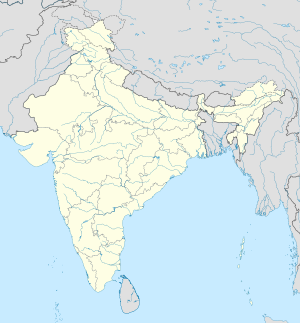Marichjhanpi
Marichjhanpi | |
|---|---|
Island | |
| Coordinates: 22°06′25″N 88°57′04″E / 22.1070°N 88.9510°E | |
| Country | |
| State | West Bengal |
| District | South 24 Parganas |
| CD Block | Gosaba |
| Elevation | 6 m (20 ft) |
| Languages | |
| • Official | Bengali, Hindi, English |
| Time zone | UTC+5:30 (IST) |
| PIN | 743370 |
| Telephone code | +91 3218 |
| Vehicle registration | WB-19 to WB-22, WB-95 to WB-99 |
| Lok Sabha constituency | Jaynagar (SC) |
| Vidhan Sabha constituency | Gosaba (SC) |
| Website | www |
Marichjhanpi is an island set in the mangrove forests of the Sundarbans in West Bengal, India. It is mostly remembered today for the incident in 1979 when the newly elected Communist Party of India (Marxist) government of West Bengal forcibly evicted thousands of Bengali refugees who had settled on the island. The government's actions resulted in the deaths of many refugees; although the exact number is unknown, researchers believe that at least several hundred people died from police brutality, disease and starvation. The Marichjhanpi massacre forms the backdrop of Amitav Ghosh's novel, The Hungry Tide.[1]
Background
The Partition of India in 1947 split the large eastern province of Bengal into two halves, along religious lines. One half became West Bengal, a Hindu-majority province in the new independent state of India. The other half became East Pakistan, the Muslim-majority eastern half of Pakistan, and later the independent country of Bangladesh.[2][3]
Refugee
Partition was accompanied by much bloodshed and suffering, and the mass migration of millions of people - Hindus from their ancestral lands in East Pakistan across to India, Muslims from India trekking in the opposite direction. This cross-transfer of peoples continued through the decades after Partition, although at a much slower rate. While the educated upper classes were able to settle themselves in the urban environs of Calcutta, the poor Hindus were moved to areas outside West Bengal, in inhospitable terrain in Orissa and Chhattisgarh. Dry forest regions usually inhibited by the adivasis, a region broadly called Dandakaranya. There they lived in concentration camp like conditions. Similar looking huts or tarpaulin tents were put up to be crammed with refugees. The boundaries were surrounded by barbed wires and guarded. The places were named Permanent Liability Camps.[4]
Invitation to Bengal
The main party of opposition in Bengal the CPI(M) continually provided voice to these refugees from Bangladesh from the outset. They argued that rehabilitation of all Bengali speaking refugees was possible within West Bengal and called upon all refugees to go there. They even assured that once in power they will all be rehabilitated in Bengal. The other view towards this generous gesture is that the CPI(M) was looking to develop a mass base among the considerable number of Refugees already in Bengal, plus encourage more to come into Bengal. In a demonstration in a refugee camp in Dandakaranya, the leader of CPI(M) himself invited all of them to Bengal, and the response he got was overwhelming.
The exodus
The refugees took the invitation to be genuine and as soon as the Left Front government first came to power in Calcutta in 1977, the refugees decided to move back to West Bengal. The refugees had a committee named Udbastu Unnyansil Samity who sent representatives to Bengal. And they decided upon settling in Marichjhanpi an island in Sunderbans. The CPI(M) however was no more enthusiastic about them. Now in power they seriously started to consider the impact such exodus might have. However they decided not to be too antagonistic from the beginning and mentioned that the refugees may come but they have to settle themselves, the government will not co-operate.
This warning did not deter the refugees and many families went to the Sundarbans, especially those who were originally from the nearby district of Khulna in Bangladesh, and who already had relatives living from before in clearings in the forest.
Antagonism to the exodus
The massive inflow of refugees were met with severe and violent resistance at many places. They were detained at railway stations for days without food and water. Many were arrested and forcefully deported back to Dandyak. But that could not discourage all of the refugees who had sold off their meager belongings and decided to move out of Dandyak at any cost. Finally several groups reached at Marichjhanpi and their number was almost 40,000.
References
- ^ Pramanik, Asim (23 March 2014). "1979 Marichjhapi killings revisited". thestatesman.net. Retrieved 4 October 2014.
- ^ Chowdhury, Debdatta (2011). "Space, identity, territory: Marichjhapi Massacre, 1979". The International Journal of Human Rights. 15 (5): 664–682. doi:10.1080/13642987.2011.569333.
- ^ Mallick, Ross (2007). Development Policy of a Communist Government: West Bengal Since 1977. Cambridge University Press. p. 99. ISBN 9780521047852.
- ^ Mallick, Ross (February 1999). "Refugee Resettlement in Forest Reserves: West Bengal Policy Reversal and the Marichjhapi Massacre". The Journal of Asian Studies. 58 (1): 104–125. doi:10.2307/2658391. JSTOR 2658391.


